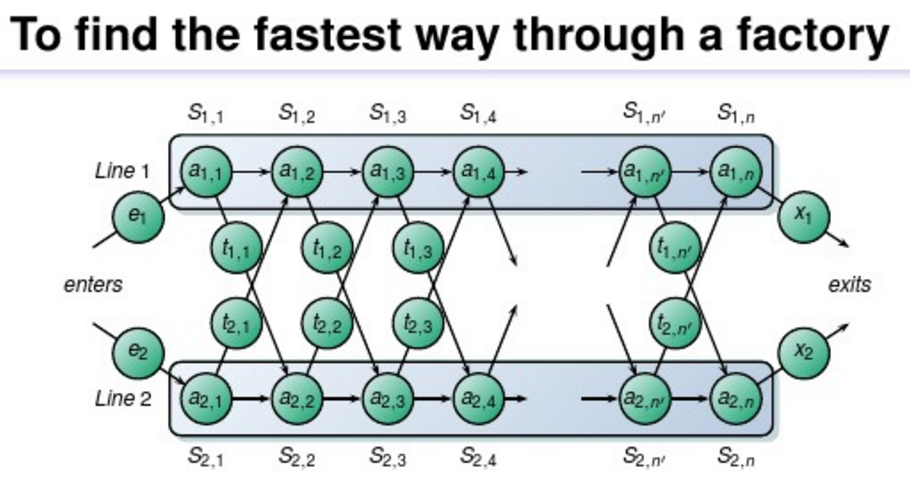本文来自于《算法导论》第二版第十五章动态规划部分的读书笔记。
理论部分
动态规划技术所适用的问题是什么?
Dynamic Programming typically applies to optimization problems in which a set of choices must be made in order to arrive at an optimal solution.
我的理解:动态规划主要用来解决最优化问题,并且是需要多阶段决策的。
As choices are made, sub-problems of the same form often arise.Dynamic Programming is effective when a given sub-problem may arise from more than one partial set of choices.the key technique is to store the solution to each such sub-problem in case it should reappear.我的理解:这一部分其实说明DP技术的基础其实是divide and conquer,也是不断的切分原问题为子问题,后者与原问题有同样的形式。并且,同一子问题是会反复出现的,在决策的过程中可能会多次产生同样的子问题,所以DP技术通过存储每个子问题的解,来使算法变得高效。
什么时候用动态规划( Elements of dynamic programming )
Optimal Substructure
An optimal solution to a problem contains within it an optimal solution to sub-problems.We refer to this property as optimal substructure.Whenever a problem exhibits optimal substructure. It is a good clue that dynamic programming might apply.我的理解:本段说了DP适用问题的第一个特点,就是原问题的解结构具有最优子结构的性质,这种形式是说原文题的最优解内含了子问题的最优解。
Overlapping Problems
Dynamic Programming is applicable when the sub-problems are not independent, that is , when sub-problems share sub-problems.When a recursive algorithm revisits the same problem over and over again, we say that the optimization problem has overlapping sub-problems.我的理解:这一部分讲了DP适用问题的第二个特点,这个角度是从问题去说的,上面的角度是从解的结构去说的。即在递归的过程中贡献子问题的时候,那么就会出现对于同一问题的重复求解。DP通过保留子问题解的方法,避免了这种情形的发生。
动态规划的解题步骤(Steps of dynamic programming)
- Characterize the structure of an optimal solution
- Recursively define the value of an optimal solution
- Compute the value of an optimal solution in a bottom-up fashion.
- Construct an optimal solution from computed information.
我的理解:
通常情况下第一步应该是判断原问题是否满足DP使用的条件,主要是分析是否具有最优子结构。如果具有最优子结构,那么可以按照如下步骤:
1.状态定义(每个阶段子问题最优解)
2.转移函数
3.初始化
4.自底向上求解
问题
To find the fastest way through a factory.
这个问题我简述下:
一个产品的出场要经过多道工序的加工方可出场。某工厂有两条工作线,每条工作线都具有n道工序。并且对应位置的工序执行相同的操作,但是他们具有不同的时间代价。在同一条工作线当中,由当前工序转移到下一道工序是没有时间代价的,但是从不同的工做线转移是具有时间代价的。
现在的问题就是:给出每条工作线各个工序的时间代价,以及不同工作线工序互相转移的时间代价。求出一个产品出厂前所要经历的最短时间。如下图所示:
分析
首先,分析原问题解的结构。
假设, S1,j 是原问题最优解所经历的工序,当 S1,j 来自于 S1,j−1 时, S1,j−1 一定也是原问题最优解所经历的工序。即 S1,j 是最快的,而它又来自于 S1,j−1 ,那么 S1,j−1 也一定是最快的。否则,如果到达 S1,j−1 不是最快的,那么我们用更快的那条路到达 S1,j ,则这条路是要比原来那条路更快的,而这与假设 S1,j 是最快的互相矛盾。所以,如果即 S1,j 是最快的,而它又来自于 S1,j−1 ,那么 S1,j−1 也一定是最快的。
所以,有如下的结论:
The fastest way through station
S1,j
, is either
- The fastest way through station S1,j−1 or,
- The fastest way through station S2,j−1
同样的,
The fastest way through station
S2,j
, is either
- The fastest way through station S1,j−1 or,
- The fastest way through station S2,j−1
那么,由对原问题的分析,我们可以定义如下的最优函数,以及转移函数
Let
fi[j]
denote the fastest possible time through station
Si,j
最优函数:
转移函数:
代码
#include <iostream>
#include <fstream>
#define LOCAL
const int maxn = 32;
int s1[maxn]; // station1[j]
int s2[maxn]; // station2[j]
int t1[maxn]; // time cost of s1[j-1] to s2[j]
int t2[maxn]; // time cost of s2[j-1] to s1[j]
int dp1[maxn]; // fastest path through s1[j]
int dp2[maxn]; // fastest path through s2[j]
int flag1[maxn]; // which line from [j-1] to s1[j]
int flag2[maxn]; // which line from [h-1] to s2[j]
int ans[maxn];
int main()
{
#ifdef LOCAL
std::ifstream cin( "input.dat" );
std::ofstream cout( "output.dat" );
#endif
int n = 0;
while( cin >> n )
{
int e1, x1;
int e2, x2;
cin >> e1 >> x1;
cin >> e2 >> x2;
for( int i = 0; i < n; ++i )
cin >> s1[i];
for( int i = 0; i < n; ++i )
cin >> s2[i];
for( int i = 0; i < n-1; ++i )
cin >> t1[i];
for( int i = 0; i < n-1; ++i )
cin >> t2[i];
dp1[0] = e1 + s1[0];
dp2[0] = e2 + s2[0];
flag1[0] = 1;
flag2[0] = 2;
for( int j = 1; j < n; ++j )
{
// 处理第一条流水线
if( dp1[j-1] < dp2[j-1] + t2[j-1] )
{
flag1[j] = 1;
dp1[j] = dp1[j-1] + s1[j];
}
else
{
flag1[j] = 2;
dp1[j] = dp2[j-1] + t2[j-1] + s1[j];
}
// 处理第二条流水线
if( dp2[j-1] < dp1[j-1] + t1[j-1] )
{
flag2[j] = 2;
dp2[j] = dp2[j-1] + s2[j];
}
else
{
flag2[j] = 1;
dp2[j] = dp1[j-1] + t1[j-1] + s2[j];
}
}
int first = dp1[n-1] + x1;
int second = dp2[n-1] + x2;
int result = ( first < second )?first:second;
cout << result << std::endl;
// 寻找最优路径的station
if( first < second )
ans[n-1] = 1;
else
ans[n-1] = 2;
for( int i = n-2 ; i >= 0; --i )
{
if( ans[i + 1] == 1 ) // 对流水线进行行判断
{
ans[i] = flag1[i+1];
}
else
{
ans[i] = flag2[i+1];
}
}
for( int i = 0; i < n; ++i )
{
cout << "Station " << ans[i] << " , " << i + 1 << std::endl;
}
}
#ifdef LOCAL
cin.close();
cout.close();
#endif
return 0;
};
输入数据文件:input.dat
6
2 3
4 2
7 9 3 4 8 4
8 5 6 4 5 7
2 3 1 3 4
2 1 2 2 1
输出文件:output.dat
38
Station 1 , 1
Station 2 , 2
Station 1 , 3
Station 2 , 4
Station 2 , 5
Station 1 , 6























 1870
1870

 被折叠的 条评论
为什么被折叠?
被折叠的 条评论
为什么被折叠?








